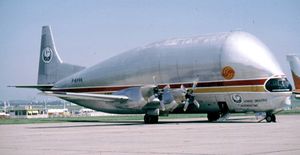PlaneSpottingWorld welcomes all new members! Please gives your ideas at the Terminal.
Aero Spacelines Super Guppy
| B-377-SG/SGT Super Guppy | |
|---|---|
| The present version of the Super Guppy used by NASA | |
| Type | Outsize cargo freight aircraft |
| Manufacturer | Aero Spacelines |
| Designed by | Leo Mansdorf/John M. Conroy |
| Maiden flight | August 31, 1965 |
| Status | Airworthy |
| Primary users | Aero Spacelines (3) NASA (2) Airbus (4) Aeromaritime (2) |
| Number built | 1 SG, 4 SGT |
| Developed from | C-97J Turbo Stratocruiser |
The Super Guppy is a large, wide-bodied US cargo aircraft used for ferrying outsized cargo components. It was the successor to the Pregnant Guppy, the first of the Guppy aircraft produced by Aero Spacelines, Inc. Five were built in two variants, both of which were colloquially referred to as the "Super Guppy."
Super Guppy versions
The first, the Super Guppy, or "SG", was built directly from the fuselage of a C-97J Turbo Stratocruiser, the military version of the Boeing 377. The fuselage was lengthened to 141 feet (43 m), and ballooned out to a maximum inside diameter of 25 ft (7.6 m), the length of the cargo compartment being 94 ft 6 in (28.8 m). The floor of the cargo compartment was still only 8 ft 9 in (2.7 m) wide, as necessitated by the use of the Stratocruiser fuselage.
In addition to the fuselage modifications, the Super Guppy used upgraded Pratt & Whitney T-34P7 turboprops for increased power and range, and modified wing and tail surfaces. It could carry a load of 40,000 pounds (18,000 kg) and cruise at 300 mph (480 km/h).
The second version was officially known as the Super Guppy Turbine (SGT) because the original 377 engines had been replaced with high-performance Allison 501-D22C turboprops. Unlike previous Guppies, the fuselage was constructed from scratch. By building from scratch, Aero Spacelines was able to widen the floor of the cargo compartment to 13 ft (4 m). The overall cargo compartment length was increased to 111 ft (33.8 m), and the improved fuselage and engines allowed for a maximum load of 54,500 pounds (24,700 kg). These design improvements, combined with a pressurized crew cabin that allowed for higher-altitude cruising, allowed the SGT to transport more cargo than its predecessors.
The SGT retained only the cockpit, wings, tail, and main landing gear of the 377. The nosegear was taken from the Boeing 707 -- and reversed 180 degrees. This dropped the front of the aircraft slightly, leveling the cargo bay floor and simplifying loading operations.
In the early 1970s, four Super Guppies were used by Airbus Industrie to transport aeroplane parts from decentralised production facilities to the final assembly plant in Toulouse. The running joke was "Every Airbus is delivered on the wings of a Boeing". The super Guppies have since been replaced by the Airbus Beluga, capable of carrying twice as much cargo.
Only one Super Guppy remains in service: an SGT flown by NASA. The other four are mothballed; the SG at Pima Air and Space Museum, Davis-Monthan Air Force Base, Arizona, the first SGT at Bruntingthorpe, UK, the second outside Airbus' factories at Blagnac Airport, Toulouse, France, and the third at Finkenwerder, Germany.
Specifications (Super Guppy Turbine)
Data from {name of first source}
General characteristics
- Crew: Four
- Length: 143 ft 10 in (43.84 m)
- Wingspan: 156 ft 3 in (47.625 m)
- Height: 46 ft 5 in (14.148 m)
- Empty weight: 101,500 lb (46,039 kg)
- Useful load: 54,500 lb (24,720 kg)
- Max takeoff weight: 170,000 lb (77,110 kg)
- Powerplant: 4× Allison 501-D22C turboprops, 4,680 hp (3,491 kW) each
- * Cargo bay dimensions: 111 ft x 25 ft x 25 ft (33.8 m x 7.62 m x 7.62 m)
Performance
- Cruise speed: 252 knots (288 mph, 467 km/h)
- Range: 1,734 nm (1,986 mi, 3,219 km)
- Service ceiling: 32,000 ft (9,753.6 m)
See also
Related development
Comparable aircraft
- Airbus Beluga
- Antonov An-225
- Boeing 377
- Boeing 747 Large Cargo Freighter
- Conroy Skymonster
- Myasishchev VM-T
See also
Lists relating to aviation | |
|---|---|
| General | Timeline of aviation · Aircraft · Aircraft manufacturers · Aircraft engines · Aircraft engine manufacturers · Airports · Airlines |
| Military | Air forces · Aircraft weapons · Missiles · Unmanned aerial vehicles (UAVs) · Experimental aircraft |
| Notable incidents and accidents | Military aviation · Airliners · General aviation · Famous aviation-related deaths |
| Records | Flight airspeed record · Flight distance record · Flight altitude record · Flight endurance record · Most produced aircraft |
External links
- NASA Super Guppy home page
- Johnson Space Center's Super Guppy page
- Page about the Boeing B-377, the plane all Guppies were based on
- "All About Guppys" - Extensive information on all of the Guppy Aircraft, including many photographs and drawings.
Lists relating to aviation | |
|---|---|
| General | Timeline of aviation · Aircraft · Aircraft manufacturers · Aircraft engines · Aircraft engine manufacturers · Airports · Airlines |
| Military | Air forces · Aircraft weapons · Missiles · Unmanned aerial vehicles (UAVs) · Experimental aircraft |
| Notable incidents and accidents | Military aviation · Airliners · General aviation · Famous aviation-related deaths |
| Records | Flight airspeed record · Flight distance record · Flight altitude record · Flight endurance record · Most produced aircraft |
de:Guppy (Flugzeug) fr:Aero Spacelines Super Guppy hr:Super Guppy hu:Aero Spacelines Super Guppy ja:スーパーグッピー
| This article is licensed under the GNU Free Documentation License. It uses material from the Wikipedia article "Aero Spacelines Super Guppy". |


